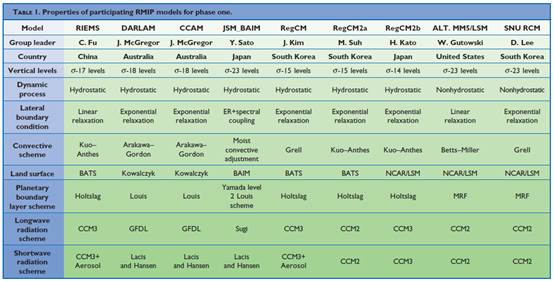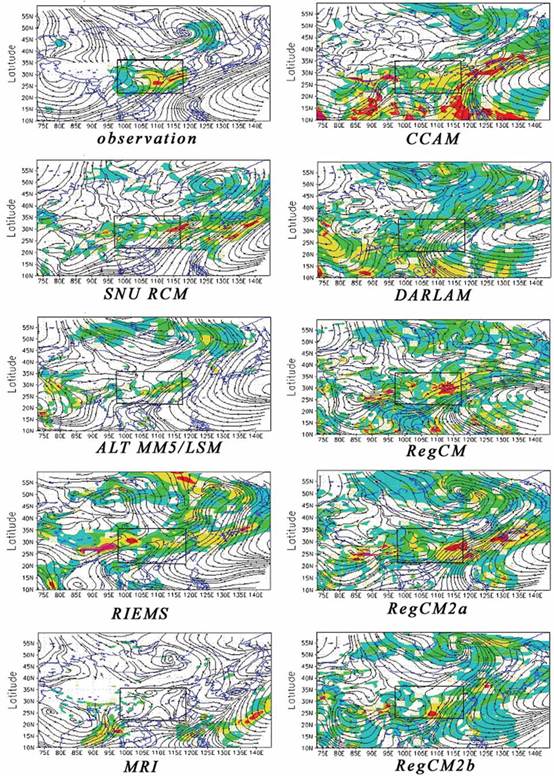Improving the simulation of regional climate change is one of the high-priority areas of climate study because regional information is needed for
climate change impact assessments. Such information is especially important for the region covered by the East Asian monsoon where there is high
variability in both space and time. To this end, the Regional Climate Model Inter-comparison Project (RMIP) for Asia has been established to
evaluate and improve regional climate model (RCM) simulations of the monsoon climate. RMIP operates under joint support of the Asia–Pacific
Network for Global Change Research (APN), the Global Change System for Analysis, Research and Training (START), the Chinese Academy of
Sciences, and several projects of participating nations. The project currently involves 10 research groups from Australia, China, Japan, South
Korea, and the United States, as well as scientists from India, Italy, Mongolia, North Korea, and Russia.

TABLE 1. Properties of participating RMIP models for phase one.
RMIP seeks to improve further RCM simulations of the East Asian climate by evaluating its strengths and weaknesses in a common framework.
The specific objectives
of RMIP are:
1) to assess the current status of East Asian regional climate simulation,
2) to provide a scientific basis for further RCM improvement, and
3) to provide scenarios of East Asian regional climate change in the twenty-first century based on an ensemble
of RCMs that are nested within a GCM.
PROJECT DESIGN.
A three-phase simulation program is underway to meet these objectives.
Phase one: This 18-month simulation (March 1997–August 1998) covers a full annual cycle––East Asian drought and heat waves during the
summer of 1997, and flooding in Korea, Japan, and the Yangtze and Songhua River valleys of China, during the summer of 1998. Phase-one
tasks entail examining model capabilities to reproduce the annual cycle of monsoon climate and to capture extreme climate events.
To date, nine models from five countries have contributed to RMIP’s phase one (Table 1). These include eight limited-area models and
one global variable resolution model, the Conformal-Cubic Atmospheric Model (CCAM). Detailed model information is listed in the appendix.
Phase two: This 10-yr simulation (January 1989–December 1998) assesses the models’ ability to reproduce statistical behavior of the
Asian monsoon climate.
Phase three: Simulations with RCMs driven by GCM output under different forcing scenarios, including changes of atmospheric CO2
concentration, sulfate aerosol emissions,
and land cover are made. Phase-three tasks aim at providing improved climate change scenarios and uncertainty estimates for East Asia
through an ensemble of model simulations.

FIG. 1. Total precipitation (mm) and 850-hPa streamlines for 11–20 Jun 1998.
详见:
Fu, Congbin, and Coauthors, 2005: Regional Climate Model Intercomparison Project for Asia.
Bull. Amer. Meteor. Soc., 86, 257–266. doi: http://dx.doi.org/10.1175/BAMS-86-2-257

